There is no absolute best kitchen knife for every person. Different budgets, grip styles and aesthetic tastes, not to mention a dozen other micro-decisions, all determine which knife is best for the task at hand.
Products in the Guide
-
Tojiro DP Gyutou
Read more -
Miyabi SG2 Chef’s Knife
Read more -
Victorinox 8” Chef’s Knife
Read more -
Mac Mighty Professional Hollow Edge Knife
Read more -
Zwilling Pro 8-Inch Chef’s Knife
Read more -
Shun Cutlery Classic Santoku Knife 5.5
Read more -
Misono UX10 Petty Knife
Read more -
Global G-2
Read more -
Takamura R2 Santoku
Read more -
Middleton Made Knives 8” Echo Chef’s Knife
Read more -
Misen Chef’s Knife
Read more -
Made In Chef’s Knife
Read more -
Kalamazoo Kitchen Knife Set
Read more -
Wüsthof Classic 9-Piece Knife Block Set
Read more
This guide aims to identify which kitchen knives are best out of the box, hold up the longest and generally offer the most value for your dollar. Our chosen chef knives have all been personally vetted by our team of testers who set out to find the most useful kitchen knives available. Weighing balance, price, materials, craftsmanship and necessity, we’ve narrowed your choice down to 14 kitchen knives — here’s where the chips fell.
How We Tested
 Gear Patrol Staff
Gear Patrol StaffAll of our testers were equipped with kitchen knives to hack, chop and slice their way to their findings. We judged their sharpness from straight out of the box to how they fared after long-term usage. Besides sharpness, we judged kitchen knives based on how they felt in hand (did they feel sturdy and durable?), how they felt to use after long bouts of cutting, how versatile they were at slicing and chopping various foods and how easy they were to hone and resharpen. Another important factor for judging kitchen knives was price. Higher price tags don’t necessarily mean a knife is better, so for the blades that cost a pretty penny, we wanted to make sure their usage and longevity were worth the premium.
To learn more about our testing methodology and how we evaluate products, head here.
Best Overall Chef Knife
 Amazon
AmazonTojiro DP Gyutou
-
$120.00 (16% off)
Pros
- Super sharp out of the box
- Stain- and rust-resistant
- Balanced weight
Cons
- Narrow width; those with larger hands may wish for more knuckle clearance
- Ultra-thin blade isn't suited to cutting hard vegetables
- Your family might be afraid to use it
The ideal balance of price, performance and materials. Knife emporium ChefKnivestoGo describes Tojiro’s DP series as “the gateway into the world of high-end Japanese cutlery.” Simply put, you will be hard-pressed to find a blade that’s made better than this one for around $100. The Tojiro DP Gyuto is a full-tang VG10 stainless steel knife. At just under 2 millimeters wide, the blade is thin like a Japanese knife, but the knife is heavier than most Japanese knives, solving the common issue many new Japanese knife owners have with their blades (Western knives tend to be heavier and thicker). The steel type is fairly common for a mid-priced knife, but because the core of the knife is laminated with a softer steel, it’s much easier to sharpen than most.
 Cam Oden
Cam OdenOur tester describes it as being both lighter and sharper than his collection of Western-style knives, and saves his usage as a “special treat” when a recipe calls for some special knifework. He also notes that everyone else in his household is scared of the knife, finding it too intimidating. Altogether, there isn’t a knife — Japanese or otherwise — that offers as much performance for the money.
Best Upgrade Chef Knife
 zwilling
zwillingMiyabi SG2 Chef’s Knife
-
$349.99 (14% off)
Pros
- Very sharp
- Comfortable handle
- Beautiful Damascus pattern
Cons
- SG2 steel requires special sharpening
Made in Seki, Japan with SG2 micro-carbide steel sandwiched between 100 layers of Damascus steel, this knife is incredibly sharp, durable and beautiful. The hand-honed blade has a 63 Rockwell Hardness and an edge between 9.5° and 12°. The D-shape handle is made of Karelian birchwood and features a mosaic pin accent. This knife is lightweight and precise and excels at most slicing, chopping, dicing and mincing tasks.

It comes with a very sharp factory edge and maintains its edge well. It is a big step above Shun knives and aesthetically more interesting than many contemporary knives. At the list price of $440, there are many knives from smaller Japanese makers that provide strong competition, but many retailers (Amazon included) will sell you one for well under SRP.
Best Budget Chef Knife
 Amazon
AmazonVictorinox 8” Chef’s Knife
-
$45.92 (9% off)
Pros
- Very versatile
- Easy to clean, sharpen and store
- Extremely durable if taken care of properly
Cons
- Not great for cutting large fruits or veggies
This is one of our testers’ absolutely favorite knife in her kitchen quiver due to its versatility and ease of use. The size and handling are comfortable and provide a reliable grip and ergonomic positioning when cutting foods of most shapes and sizes, though it’s not quite beefy enough to handle large, hard fruits and veggies like watermelon or butternut squash.
Our tester describes herself as a “clean while I cook person” and has always found this knife easy and pain-free to wash after chopping, dry it off with a kitchen towel and toss it in her drawer’s knife holder.
Best Japanese Chef Knife
 Amazon
AmazonMac Mighty Professional Hollow Edge Knife
-
$175.00 (11% off)
Pros
- Perfect balance and weight
- Easy to sharpen
Cons
- Will rust if not dried quickly after washing
- Dimples don't really help sticky foods slide off
Mac makes a number of more affordable blades, but its Pro series is when the brand starts to become superlative (it’s about $50 more than the more popular Mac chef’s knife, but it’s worth it). The full-tang construction feels solid in the hand without being needlessly heavy, and the laminated steel used in the Pro version is miles better for edge retention and general sharpness.
This knife’s base thickness is 2.5 millimeters, which is more than 20 percent thicker than our top pick, the Tojiro gyutou. This makes it more of an all-purpose knife (starches and hardy vegetables are not an issue), but also means it doesn’t glide through softer fruits and vegetables as gracefully. The higher carbon content in the blade makes small rust spots commonplace if you don’t wash and immediately dry the knife after use (unlike true carbon steel knives, though, highly acidic items like lemons or limes don’t immediately stain the knife). After using this knife for more than two years, it’s the Japanese knife we recommend for the price. We also like Mac’s 25-year warranty against material and construction defects.
Best German Chef Knife
 Sur la Table
Sur la TableZwilling Pro 8-Inch Chef’s Knife
-
$238.00 (20% off)
Pros
- Classic knife brand with a history of excellence
- Designed to be used with a pinch grip
Cons
- Quite heavy
- End of handle has a weird curve; awkward for big hands
A Western-style knife (sometimes called a German-style knife) is typically going to be heavier and have a thicker blade than a Japanese-style knife. Most Western-style knives sport more defined handle ergonomics as well (more details here). The category of Western-style chef’s knife is very, very large, but after testing two dozen of them, Zwilling’s 8-inch takes the cake. It is a stainless steel knife (the exact properties of the steel are proprietary) that’s stain- and corrosion-resistant. After months of testing, the blade didn’t chip or show signs of dulling in any way.
The largest differentiating factor between Zwilling’s 8-inch and Wüsthof’s highly recommended forged 8-inch ($170) was the bolster. The Zwilling knife’s bolster fades into the blade less dramatically than the Wüsthof which, when using a pinch grip, was a lot more comfortable. That said, both got on sale fairly frequently and are solid buys.
Best Santoku Knife
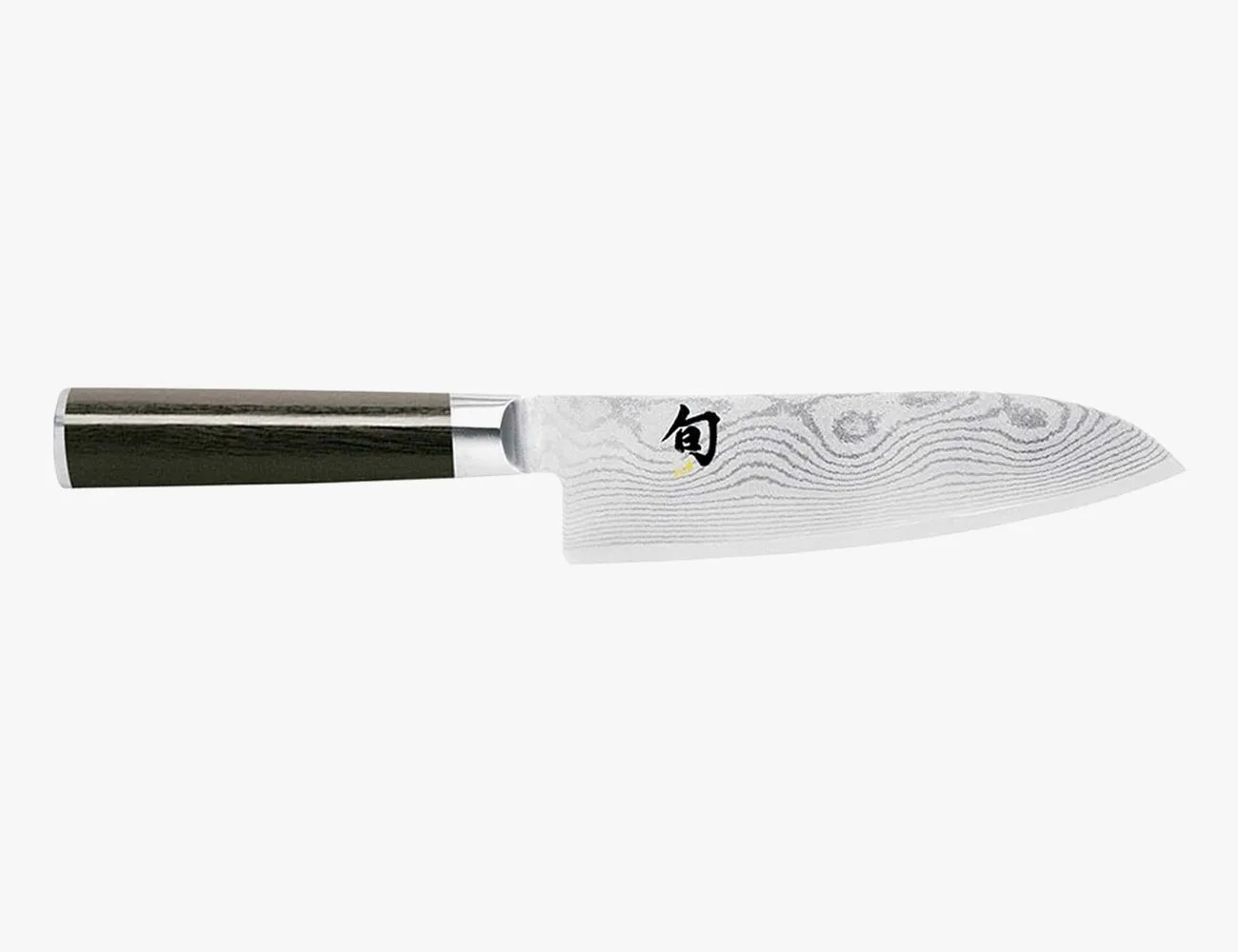 Amazon
AmazonShun Cutlery Classic Santoku Knife 5.5
Pros
- Durable
- Comfortable in hand
Cons
- Not the sharpest knife out there
- For the price one can get other nice Japanese knives
If you’re in the market for a Japanese kitchen knife, you’ve certainly come across Shun blades. The brand’s classic series knives, like this Santoku, have blades that are a step up from entry-level brands. Made in Seki, Japan, this knife features a VG-MAX cutting core that’s clad in 68 layers of stainless Damascus steel (34 on each side of the blade). The D-shape pakkawood handle is waterproof and comfortable, too. From the factory, these are functionally sharp — with a Rockwell hardness of 60 – 61 and a double-bevel blade angle of around 16°. They’re corrosion-resistant and have solid edge retention.

The classic series aren’t lasers, but they’re decent workhorse knives that won’t easily chip or dull. After over a decade of use, our tester still reaches for the 5.5-inch santoku routinely when doing quick prep work on small cutting boards. He’s also used Shun‘s 6-inch chef’s knife and the paring knife (as well as the nakiri), but finds the most day-to-day utility in the santoku shape. Is it the sharpest, fastest or hardest knife out there? Not at all. Is it a good step up for a home chef who wants something that will stand up to daily use for years? You bet!
Chef’s Choice Kitchen Knife
 Amazon
AmazonMisono UX10 Petty Knife
-
$106.82 (7% off)
Pros
- Professionally tested and vetted
- Maintains an edge
- Great balance of sharp and durable
- Lightweight
Cons
- Not as hard as some other knives
- More competition out there than a decade ago
If you were to survey chefs cooking in professional kitchens around the world about their everyday knives, the Misono UX10 would come up again and again. Fifteen years ago, it was one of the go-to knives (along with more expensive Nenox knives) and was used by everyone from David Kinch to Danny Bowien to Tim Hollingsworth. The UX10’s hand-forged blade is made of Swedish Sandvik 19C26 stainless steel and features a 60 Rockwell Hardness and 90/10 double-bevel edge. Manufactured in Seki, Japan, it has a laminated black wood handle with stainless rivets and nickel silver bolster.

The knife may look similar to Western-style knives from Wüsthof, but it’s a world apart. It’s incredibly lightweight and has a thin, precise blade that’s ideal for most prep work. Depending on the size of your kitchen, you can opt for a 180mm or 210mm chef’s knife or if you’re limited for space and/or already have a favorite chef’s knife, opt for the 130mm or 150mm petty knife seen here. The petty knife size fills the space between a traditional chef’s knife and a paring knife, making it ideal for a range of tasks — a utility knife for many professional chefs. And in small kitchens, it can even fill the role of a full-size knife. Our tester found the 150mm petty knife to be more than enough blade for everything from breaking down a chicken to cleaning and coring a pineapple to mincing fresh herbs. Because the blade is shorter than traditional chef’s knives, you may have to position your hand off the cutting board so your knuckles don’t hit the surface or adjust your hand grip — our tester personally didn’t find any issues with this, though.
Best Japanese-Style Chef Knife for Beginners
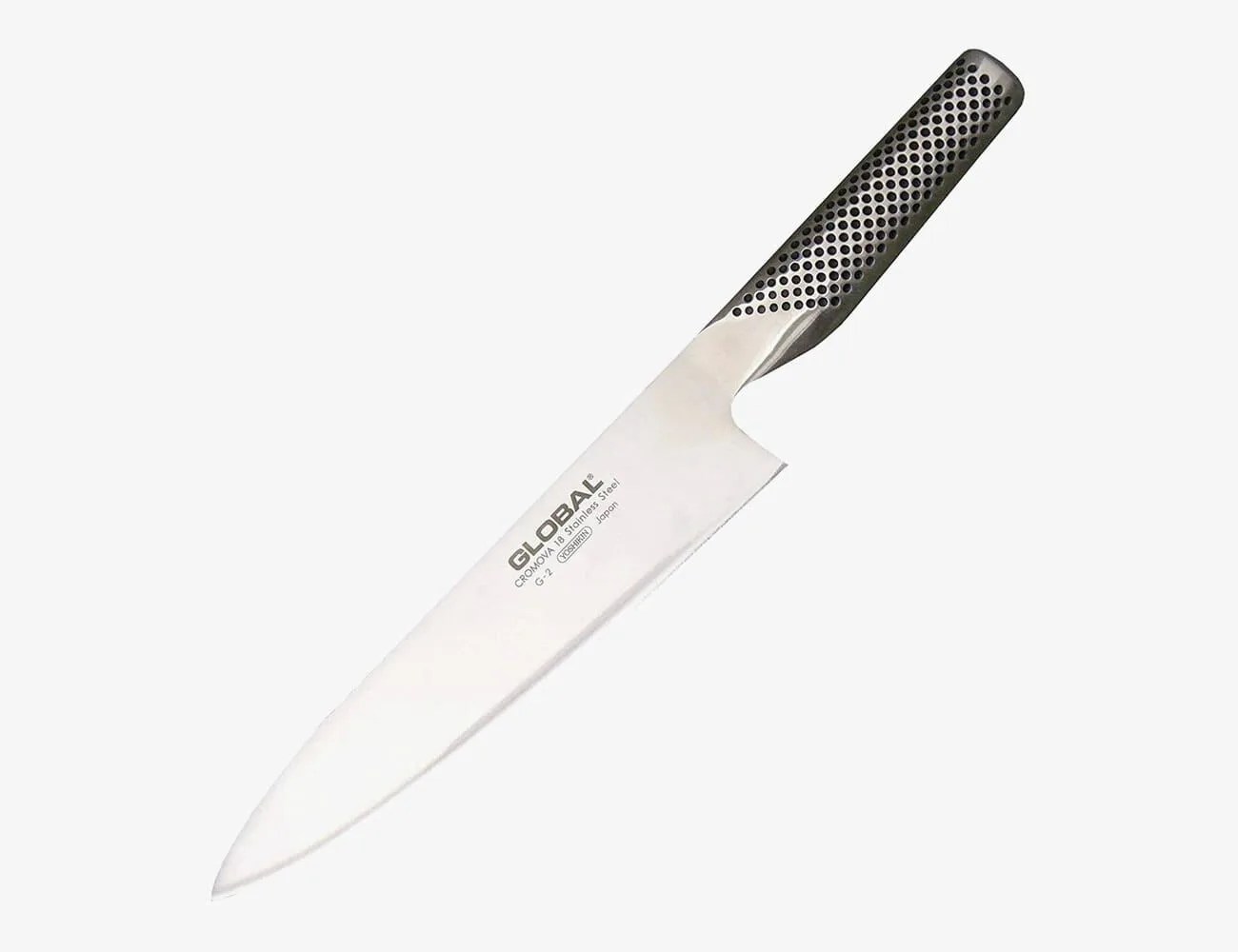 Amazon
AmazonGlobal G-2
-
$159.00 (32% off)
Pros
- Balances properties of both Japanese and Western knife design
- Gyuto-style shape is ideal for slicing
- Lightweight and easy to control
Cons
- Edge retention is only okay
- Integrated handle is polarizing
When it debuted in the 1980s, the G-2 introduced many Western cooks to Japanese-style knives. Today, it’s seen as a hybrid option, balancing the shape and weight of a gyuto with better edge retention. Some purists scoff at the integrated steel handle, but our tester loves the way it feels in his hand, and the lightweight construction makes it his preferred knife for slicing and everyday cooking. The blade is slightly thicker than a traditional gyuto, so it handles root vegetables particularly well.

Durability is a two-sided coin. On one hand, it’s tougher than other Japanese chef’s knives in our tester’s arsenal, but edge retention isn’t exactly exceptional because Global uses a softer steel. That said, our reviewer is coming up on a decade of near-daily use with his G-2 and it continues to perform to a high level with only the occasional sharpening. It also resists rust better than other knives. The G-2 is a great option for beginner cooks who want a Japanese-style knife but don’t want the headache of heavy maintenance that often accompanies them.
Sharpest Chef Knife
 Takamura Knives
Takamura KnivesTakamura R2 Santoku
Pros
- Incredibly sharp
- Great edge retention
- Very lightweight
Cons
- R2 steel requires special sharpening
- Finding one to buy can be difficult
- No-frills design (for those who like Damascus patterns)
Ask most chefs who know their knives and they’ll say you just can’t beat the Takamura R2 for the price. It’s a no-frills, all-performance knife that’s scary sharp and hyper precise. The san-mai blade is made from R2 powdered steel with a 63 Rockwell hardness and the knife features a red pakkawood handle and a stainless steel bolster. A quick look through the forums shows a common theme comparing Takamura’s R2 series to high-end sports cars. One Reddit user said: “Using it feels similar to what I imagine driving a Ferrari would be like coming from a Toyota Camry.” On kitchenknifeforums.com, a user asked whether they should get a Takamura or a Miyabi and one response noted, “It’s a bit like asking ‘which car to buy, Ferrari or SUV’.”

The Takamura R2 blade is the sharpest factory blade our most experienced tester has ever experienced and it holds its edge very well. It’s the best bang-for-you-buck knife available, but it should only be used by those who are very confident in their knife skills. The cliche ‘like a hot knife through butter’ applies in a very real way when slicing through almost anything — gravity does the work and the knife seems to just fall through whatever you’re slicing. If you’ve got a smaller kitchen space, opt for the santoku blade. But if you have more space, the brand offers both chef’s and petty knife shapes.
Best Made-in-USA Knife
 Amazon
AmazonMiddleton Made Knives 8” Echo Chef’s Knife
Pros
- Beautiful, handmade design
- Very comfortable in hand
- Excellent at fine cutting tasks
Cons
- Thinness and lightweight take some getting used to
- Included sheath is not up to par
Quintin Middleton makes one hell of a knife, and you can surprisingly pick up an “entry-level” blade from the craftsman on Amazon (read our profile on Middleton and what makes his knives special here). We put “entry-level” in quotes because it will still set you back 200 bucks, but these are handmade, American-made, heirloom-quality knives. The Echo is a Japanese-style knife with an AEB-L stainless steel blade that resists corrosion, is remarkably hard (60 on the Rockwell Scale) and comes razor-sharp out of the box. The knife’s handle is made of dyed birch veneer called Dymalux, and our tester found it to be both attractive and very comfortable in hand.
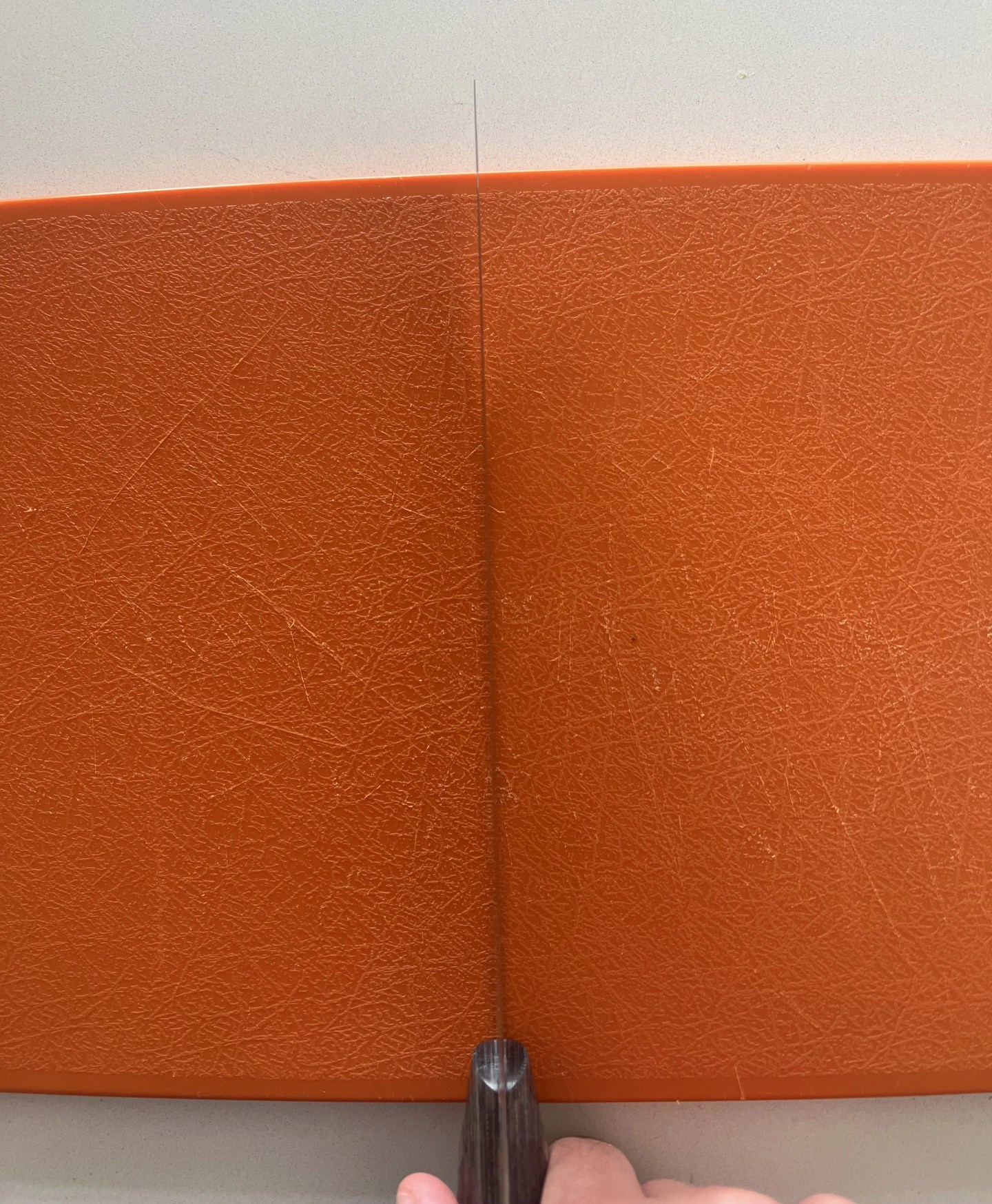
The Echo is very light and extremely thin — just 0.18mm at the edge of the 12°-angled blade. If you’re used to Western-style knives, like our tester on this knife, the lightness and thinness will definitely feel strange and you may be tempted to baby the knife but there’s really no need to do so — it’s rugged. Our tester found the Middleton was most at home when tasked with fine slicing and carving tasks, even using it to peel an apple (though he doesn’t recommend trying this). The thinness combined with the sharpness can cause some issues, however, as our tester ran into the problem of the blade catching a bit in his plastic Material cutting board. He’s never run into this issue before with any other knives, and believes the Echo will work best on rubber or butcher block cutting boards. Our tester also wishes the knife included a nicer sheath, as the included cheap plastic sleeve did not feel befitting for such a luxurious knife.
Best Value Chef Knife
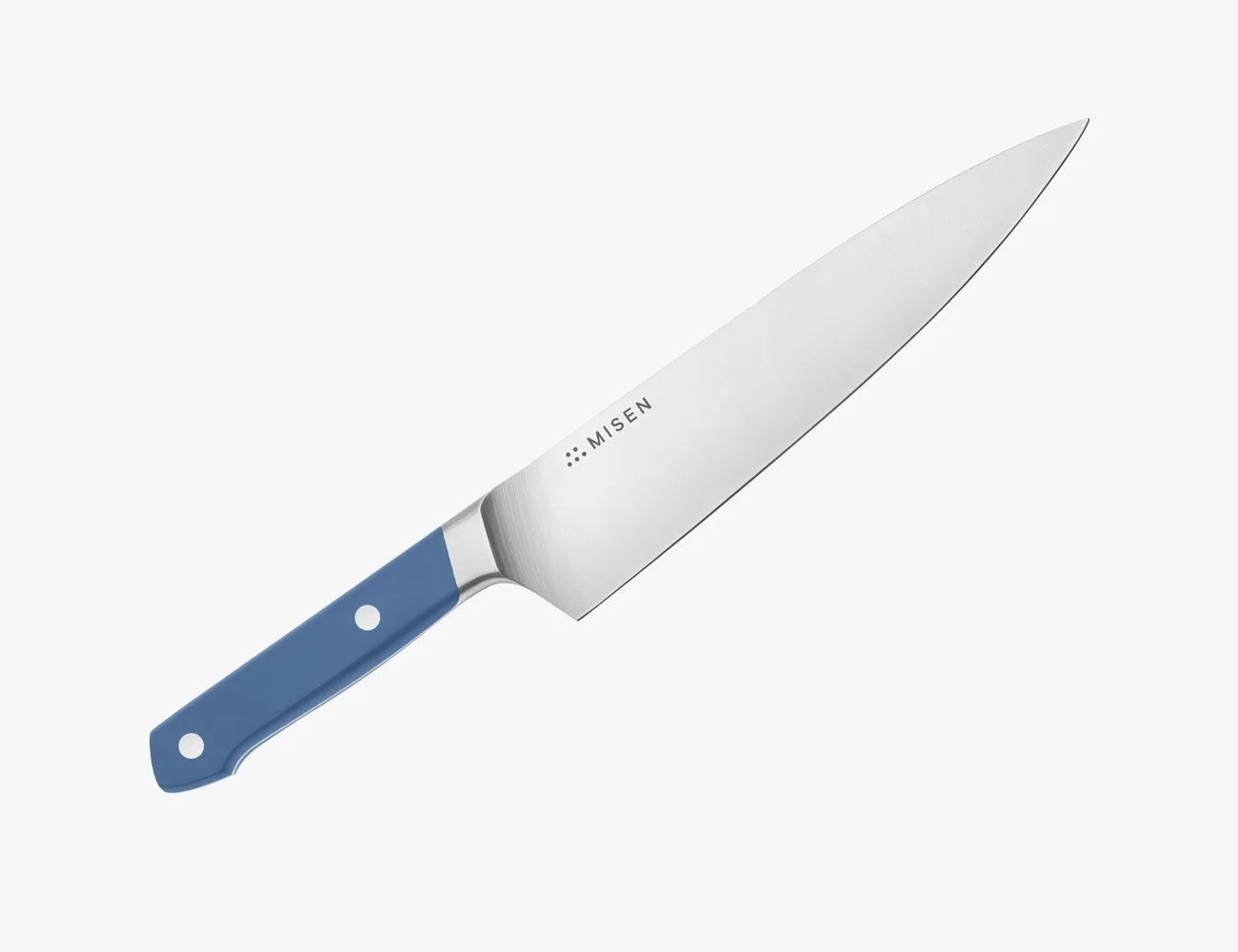 Misen
MisenMisen Chef’s Knife
Pros
- Well-designed bolster makes for an easy pinch grip
- Thin blade for precise cuts
- Misen offers free sharpening for life
Cons
- Difficult to break down harder foods
Many of the best knives we tested fold attributes from Japanese knife design into Western knife design, and Misen’s budget-friendly blade is no exception. The bolsters at the base of the blade slope and allow for an easy pinch grip. Most traditional Japanese knives will not come with this, opting instead for the handle of the knife to move directly into the blade, which can be awkward for cooks used to having a designated spot to grip. Curving down from the top and up from the bottom, the blade shape itself is also Western in origin and makes rocking the blade up and down on the cutting board easier.
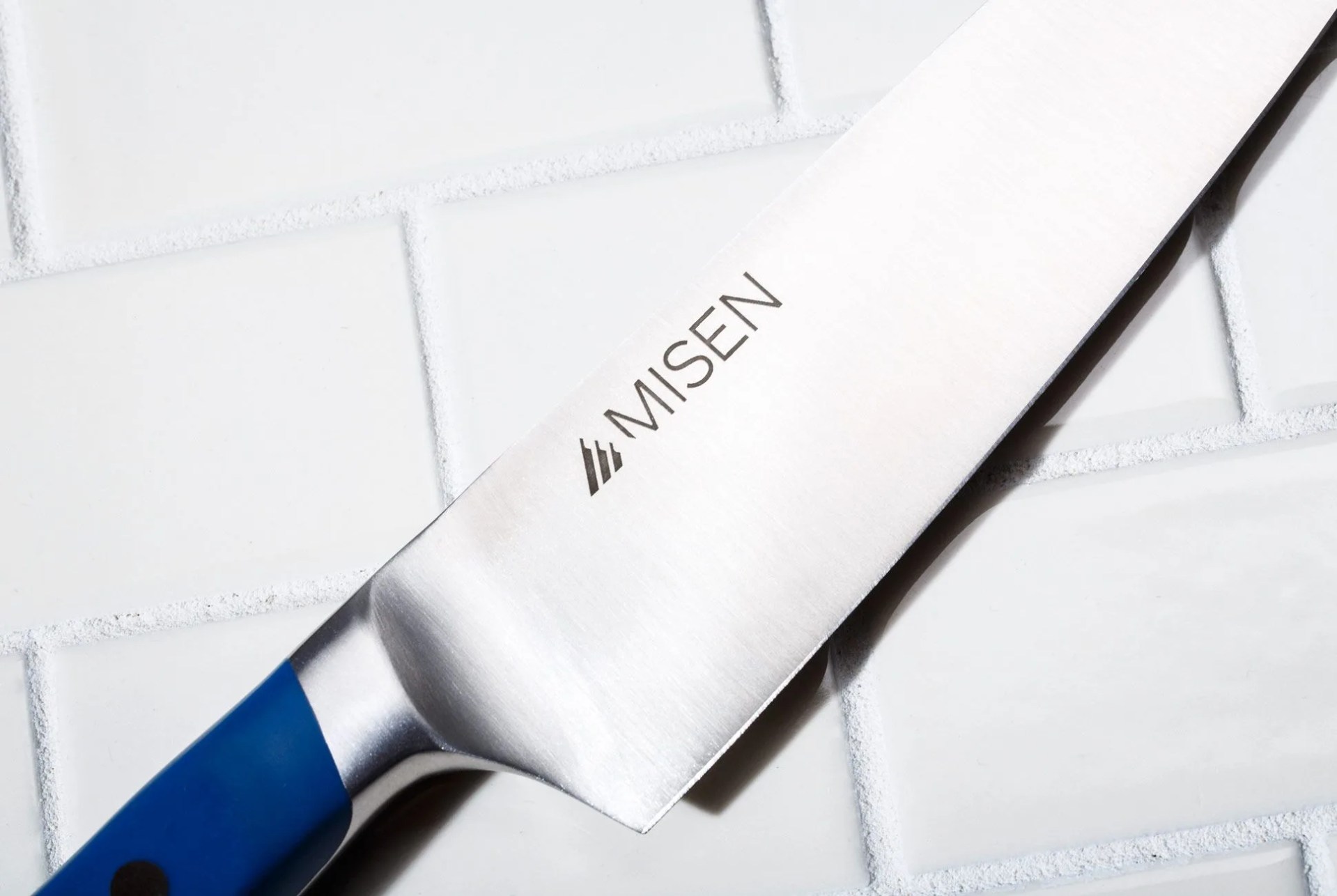
The shape and handle are rooted in Western design, but the thinness of the blade is Japanese, and this makes the Misen knife one of our top recommendations for the price. Thicker, clunkier knives at this price point can, after a month or two of use, start to feel more like a chisel than a knife; tools to break vegetables open with. The extremely thin build of the Misen knife makes for an experience more akin to surgery than brute force.
The blade did eventually dull to the point that it needed sharpening (about three months of everyday use for our tester). Thankfully, the brand guarantees free sharpening for life. Mail it back to them and you’ll have it back within a week.
Best Direct-to-Consumer Chef Knife
 Made In
Made InMade In Chef’s Knife
Pros
- Angle of knife heel prevents blisters on finger
- Fair price
- Well-balanced
Cons
- Included sheath isn't of the highest quality
- Difficult to sharpen
Direct-to-consumer brand Made In started with cookware, which remains its bread and butter, but the brand’s debut chef’s knife (released in 2018) is stellar. The blade is quite big and made with X50CrMoV15 steel (a mixture of carbon, chromium, molybdenum, vanadium, manganese and silicon), which is a staple for high-end Western blades. It is best described as a high-carbon stainless steel, meaning it carries some traits from carbon and stainless steel knives.
According to our tester, Made In’s 8-inch full-tang chef’s knife is hefty yet not too heavy. He found that the even distribution of weight helped drive into what he was cutting, even if it was squash, allowing for clean, safe cuts even when moving fast. The knife itself is also easy to clean, whether by hand or with a brush. The handle doesn’t harbor excess moisture, and it’s easy to grip. The pointed tip helps tackle smaller tasks — like juliennes — while the curved blade makes for easy chopping.
The one downside noted by our tester wasn’t actually on the knife itself but rather the sheath it comes with, which he described as far from on par with the actual tool, leading him to search for a compatible replacement.
Best Japanese Kitchen Knife Set
 AC-KTCH-KN
AC-KTCH-KNKalamazoo Kitchen Knife Set
-
$805.00 (2% off)
Pros
- Great combination of knives
- Unique design
- Durable and sharp
Cons
- Only available as a set
- Blade thickness may not be for everyone
Kalamazoo, the Chicago maker of high-end grills, offers a superlative set of kitchen knives designed by the brand’s grillmaster Russ Faulk and made in Seki, Japan. The knife set comes with an 8-inch chef’s knife, a 5-inch boning knife and a 4-inch petty knife — all with leather sheaths that are hand-sewn in Virginia. Each K-tip san mai blade has a VG-10 core hardened to 61 HRC with stainless steel outer layers. The knives have full tang handles with hand-shaped black canvas Micarta scales and polished stainless steel butt caps to balance the blades.

That said, the blades aren’t the lightest on the market, but they are certainly very sharp. What’s more, they’re designed to be used both indoors and out (prepping or plating near your outdoor grill), so they’re rugged and durable. The comfortable Micarta handles speak to this along with the spine thicknesses (3.2mm for the chef’s and boning knife, 2.3mm for the petty). Our tester found himself reaching most for the petty in day-to-day use, but also enjoyed the blade shape and performance of the chef’s knife. If you’re in the market for a handful of knives, this purpose-built set will satisfy much of what any home chef would need. If you’re looking for something much more specific and love to cook barbecue, make sure to check out the brand’s absolutely amazing brisket knife — there’s nothing else quite like it.
Best German Chef Knife Set
 Amazon
AmazonWüsthof Classic 9-Piece Knife Block Set
-
$665.00 (13% off)
Pros
- Backed by a limited lifetime warranty
- Included acacia wood block is a nice touch
Cons
- Included knives could be a bit more varied
While a good chef’s knife will cover a lot of ground in your kitchen, it’s not the perfect tool for every culinary task. So to better equip yourself to handle any countertop cutting duties that come your way, we recommend picking up a more robust kitchen knife set.
German knife maker Wüsthof is one of the world’s most respected brands when it comes to kitchen cutlery, and its Classic 9-Piece Block Set has everything you need when it comes to food prep. Each full-tang knife in the set — which includes a paring knife, bread knife, kitchen shears and more — is made in Germany from high-carbon stainless steel and is backed by a limited lifetime warranty. One of our testers is a Wüsthof devotee after having purchased the brand’s 20cm Classic Santoku Knife, and now he’s constantly on the hunt for other blades from the brand — a testament to their outstanding quality.
Kitchen Knives 101
What is the best steel for a kitchen knife?
All steel has carbon in it. Stainless steel just happens to have less carbon in it than carbon steel. What makes stainless steel different is the addition of chromium, which gives the material its signature “stainless” status. Carbon steel, on the other hand, contains much more carbon. The more carbon in the knife, the harder it is. Hardness is measured on the Rockwell scale. The harder the knife, the stronger it is. Carbon steel knives are notoriously sharp because of their strength but also hard to sharpen. They are also more prone to corroding and rust. Stainless steel knives may not be as sharp as carbon steel knives, but if you sharpen them properly, you may not even notice a difference. And while stainless steel is easier to maintain, especially when it comes to rust resistance, it’s stain-less and not stain-free.
Do I need a full-tang knife?
Tang refers to the blade that extends into the knife handle and can either stop partway, making it a partial tang knife or extend fully throughout the handle, making it a full tang knife. Full tang knives are more properly balanced because there is metal throughout the blade. Partial knives tend to be cheaper because the entire knife isn’t made of metal. Then there’s the exception of Japanese knives, which often feature a partial tang. Japanese knives use a wooden handle, which emphasizes the blade-forward balance. These are better for those who are more comfortable with their knife skills.
What is the difference between cheap and expensive knives?
Knife prices can vary from dirt cheap to outrageously expensive. It comes down to construction — like if it’s forged or stamped — and what kind of materials it’s made out of. If you’re an amateur home cook, a cheap knife is a great place to start for learning basic and essential knife skills, but a nicer blade makes quicker work of mise en place. If you’re already adept at using a kitchen knife, it’s worth the extra cost to get a knife that can further your skills in the kitchen, but many professional cooks use dirt-cheap knives. The point: you can get the job done with cheap or expensive knives, just focus on quality.
What is the difference between Japanese and German knives?
In general terms, kitchen knives fall into Japanese knife styles or German knife styles. Japanese knives tend to be thinner, sharper and harder to maintain than their German counterparts. German knives, more often than not, are more user-friendly and have a more universal appeal because of their multi-purpose nature. Japanese knives can be singular in their uses, and at the cost of having a sharper blade is the greater attention required for maintenance and care.








